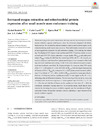Please use this identifier to cite or link to this item:
https://accedacris.ulpgc.es/jspui/handle/10553/75553
| DC Field | Value | Language |
|---|---|---|
| dc.contributor.author | Skattebo, Øyvind | en_US |
| dc.contributor.author | Capelli, Carlo | en_US |
| dc.contributor.author | Rud, Bjarne | en_US |
| dc.contributor.author | Auensen, Marius | en_US |
| dc.contributor.author | Calbet, Jose A.L. | en_US |
| dc.contributor.author | Hallén, Jostein | en_US |
| dc.date.accessioned | 2020-11-16T11:08:28Z | - |
| dc.date.available | 2020-11-16T11:08:28Z | - |
| dc.date.issued | 2020 | en_US |
| dc.identifier.issn | 0905-7188 | en_US |
| dc.identifier.other | Scopus | - |
| dc.identifier.uri | https://accedacris.ulpgc.es/handle/10553/75553 | - |
| dc.description.abstract | When exercising with a small muscle mass, the mass-specific O2 delivery exceeds the muscle oxidative capacity resulting in a lower O2 extraction compared with whole-body exercise. We elevated the muscle oxidative capacity and tested its impact on O2 extraction during small muscle mass exercise. Nine individuals conducted six weeks of one-legged knee extension (1L-KE) endurance training. After training, the trained leg (TL) displayed 45% higher citrate synthase and COX-IV protein content in vastus lateralis and 15%-22% higher pulmonary oxygen uptake ((Formula presented.)) and peak power output ((Formula presented.)) during 1L-KE than the control leg (CON; all P <.05). Leg O2 extraction (catheters) and blood flow (ultrasound Doppler) were measured while both legs exercised simultaneously during 2L-KE at the same submaximal power outputs (real-time feedback-controlled). TL displayed higher O2 extraction than CON (main effect: 1.7 ± 1.6% points; P =.010; 40%-83% of (Formula presented.)) with the largest between-leg difference at 83% of (Formula presented.) (O2 extraction: 3.2 ± 2.2% points; arteriovenous O2 difference: 7.1 ± 4.8 mL· L−1; P <.001). At 83% of (Formula presented.), muscle O2 conductance (DMO2; Fick law of diffusion) and the equilibration index Y were higher in TL (P <.01), indicating reduced diffusion limitations. The between-leg difference in O2 extraction correlated with the between-leg ratio of citrate synthase and COX-IV (r =.72-.73; P =.03), but not with the difference in the capillary-to-fiber ratio (P =.965). In conclusion, endurance training improves O2 extraction during small muscle mass exercise by elevating the muscle oxidative capacity and the recruitment of DMO2, especially evident during high-intensity exercise exploiting a larger fraction of the muscle oxidative capacity. | en_US |
| dc.language | eng | en_US |
| dc.relation.ispartof | Scandinavian Journal of Medicine and Science in Sports | en_US |
| dc.source | Scandinavian Journal of Medicine and Science in Sports[ISSN 0905-7188], v. 30(9), p. 1615-1631, (Septiembre 2020) | en_US |
| dc.subject | 241106 Fisiología del ejercicio | en_US |
| dc.subject.other | Arteriovenous Oxygen Difference | en_US |
| dc.subject.other | Blood Flow | en_US |
| dc.subject.other | Endurance Training | en_US |
| dc.subject.other | Fick Method | en_US |
| dc.subject.other | Limitations | en_US |
| dc.subject.other | Maximal Oxygen Uptake | en_US |
| dc.subject.other | Muscle Oxygen Diffusion | en_US |
| dc.subject.other | Peripheral Adaptations | en_US |
| dc.title | Increased oxygen extraction and mitochondrial protein expression after small muscle mass endurance training | en_US |
| dc.type | info:eu-repo/semantics/Article | en_US |
| dc.type | Article | en_US |
| dc.identifier.doi | 10.1111/sms.13707 | en_US |
| dc.identifier.scopus | 85085617755 | - |
| dc.contributor.authorscopusid | 56711333700 | - |
| dc.contributor.authorscopusid | 7004189630 | - |
| dc.contributor.authorscopusid | 25655368200 | - |
| dc.contributor.authorscopusid | 57215724697 | - |
| dc.contributor.authorscopusid | 7004323423 | - |
| dc.contributor.authorscopusid | 26656659300 | - |
| dc.identifier.eissn | 1600-0838 | - |
| dc.description.lastpage | 1631 | en_US |
| dc.description.firstpage | 1615 | en_US |
| dc.investigacion | Ciencias de la Salud | en_US |
| dc.type2 | Artículo | en_US |
| dc.description.numberofpages | 22 | en_US |
| dc.utils.revision | Sí | en_US |
| dc.identifier.ulpgc | Sí | en_US |
| dc.contributor.buulpgc | BU-FIS | en_US |
| dc.description.sjr | 1,575 | |
| dc.description.jcr | 4,221 | |
| dc.description.sjrq | Q1 | |
| dc.description.jcrq | Q1 | |
| dc.description.scie | SCIE | |
| item.fulltext | Con texto completo | - |
| item.grantfulltext | open | - |
| crisitem.author.dept | GIR IUIBS: Rendimiento humano, ejercicio físico y salud | - |
| crisitem.author.dept | IU de Investigaciones Biomédicas y Sanitarias | - |
| crisitem.author.dept | Departamento de Educación Física | - |
| crisitem.author.orcid | 0000-0002-9215-6234 | - |
| crisitem.author.parentorg | IU de Investigaciones Biomédicas y Sanitarias | - |
| crisitem.author.fullName | López Calbet, José Antonio | - |
| Appears in Collections: | Artículos | |
SCOPUSTM
Citations
21
checked on Jun 8, 2025
WEB OF SCIENCETM
Citations
26
checked on Jan 12, 2026
Page view(s)
89
checked on Feb 18, 2024
Download(s)
372
checked on Feb 18, 2024
Google ScholarTM
Check
Altmetric
Share
Export metadata
Items in accedaCRIS are protected by copyright, with all rights reserved, unless otherwise indicated.
